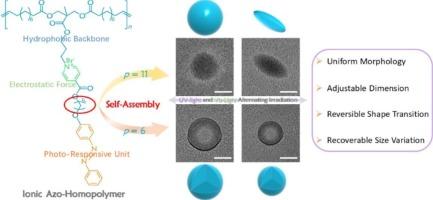由静电力和芳香-芳香相互作用驱动的光响应型离子偶氮均聚物
IF 6.3
2区 化学
Q1 POLYMER SCIENCE
引用次数: 0
摘要
精确调整自组装结构的形态和尺寸已经引起了人们的极大兴趣,但仍然具有挑战性。在此,我们开发了基于静电力和芳香-芳香相互作用的协同效应来制备具有可控尺寸的组件。采用无环二烯复合聚合的方法,系统地设计合成了两种具有吡啶阳离子基团和烷基偶氮苯悬垂的均聚物,通过改变两个功能悬垂之间的烷基链长,可以进一步自组装成球形胶束和空心囊泡。在紫外光和可见光的交替照射下,偶氮苯发色团通过不同的反式→顺式异构化效率,最终形成具有可逆形状转变的胶团和具有可恢复大小变化的囊泡,将π -π相互作用控制在适当的范围内。均匀组装体的形成和形态演化过程证实了相对强的非共价相互作用是均聚体系自组装的必要条件。更重要的是,这些球形形貌的大小可以通过改变自组装浓度来选择性地调整。我们期望协同作用和调节多种非共价相互作用在相互增强中的重要性将为诱导均聚物自组装以产生受控形态提供新的途径。本文章由计算机程序翻译,如有差异,请以英文原文为准。

Light-responsive ionic azo-homopolymer assemblies driven by the synergy of electrostatic force and aromatic–aromatic interaction
The precisely adjusting the morphology and size of self-assembled structures has attracted considerable interest but still challenging. Herein, we develop to fabricate the assemblies with controllable sizes based on the synergistic effect of electrostatic force and aromatic–aromatic interaction. Two kinds of homopolymers with pyridinium cation moiety and alkyl azobenzene pendant were systematically designed and synthesized via acyclic diene metathesis polymerization, and can further self-assemble into the spherical micelles and hollow vesicles by varying the alkyl chain length between two functional pendants. Upon alternating irradiation of UV-light and Vis-light, the micelle with reversible shape transition and the vesicle with recoverable size variation were ultimately formed through the different trans → cis isomerization efficiency of azobenzene chromophore to control π–π interaction within an appropriate range. The formation of uniform assemblies and the morphological evolution process confirmed that the relatively strong non-covalent interaction was essential for the self-assembly of homopolymer system. More importantly, the size of these spherical morphologies can be optionally adjusted by changing the self-assembly concentration. We expect that the importance of synergy and regulation multiple non-covalent interactions in reinforcing each other will offer a new avenue to induce self-assembly of homopolymer to produce the controlled morphology.
求助全文
通过发布文献求助,成功后即可免费获取论文全文。
去求助
来源期刊

European Polymer Journal
化学-高分子科学
CiteScore
9.90
自引率
10.00%
发文量
691
审稿时长
23 days
期刊介绍:
European Polymer Journal is dedicated to publishing work on fundamental and applied polymer chemistry and macromolecular materials. The journal covers all aspects of polymer synthesis, including polymerization mechanisms and chemical functional transformations, with a focus on novel polymers and the relationships between molecular structure and polymer properties. In addition, we welcome submissions on bio-based or renewable polymers, stimuli-responsive systems and polymer bio-hybrids. European Polymer Journal also publishes research on the biomedical application of polymers, including drug delivery and regenerative medicine. The main scope is covered but not limited to the following core research areas:
Polymer synthesis and functionalization
• Novel synthetic routes for polymerization, functional modification, controlled/living polymerization and precision polymers.
Stimuli-responsive polymers
• Including shape memory and self-healing polymers.
Supramolecular polymers and self-assembly
• Molecular recognition and higher order polymer structures.
Renewable and sustainable polymers
• Bio-based, biodegradable and anti-microbial polymers and polymeric bio-nanocomposites.
Polymers at interfaces and surfaces
• Chemistry and engineering of surfaces with biological relevance, including patterning, antifouling polymers and polymers for membrane applications.
Biomedical applications and nanomedicine
• Polymers for regenerative medicine, drug delivery molecular release and gene therapy
The scope of European Polymer Journal no longer includes Polymer Physics.
 求助内容:
求助内容: 应助结果提醒方式:
应助结果提醒方式:


